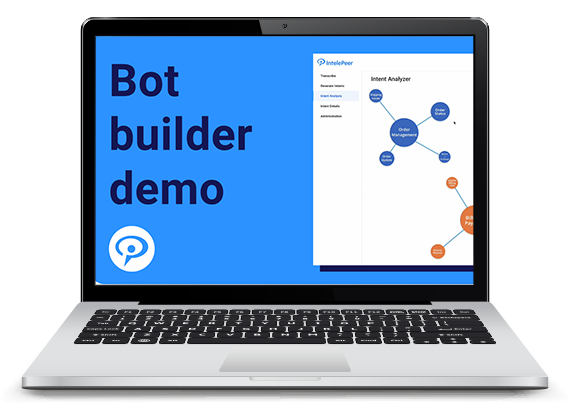We start the analysis phase with the Intent Analyzer. Here we use customer data to identify and categorize customer interactions by intent, providing the initial insight needed to identify automation opportunities. Here we see call intents clustered around intent categories. Larger circles allow us to see which intents occur more frequently than others. In addition to frequency, we can also use other characteristics of the interactions, such as duration and sentiment, to change the visualization and bring focus to those intents and KPIs that matter to the business. For example, by filtering on calls with duration of over 5 minutes we can see that order status intent has a high number of calls with long durations. Let’s drill into the order status intent for more details by clicking the order status intent. Here we see details of order status interaction. Details include: the number of occurrences, average duration, and average sentiment. We even see details about the steps that the human agents are taking to address order status interactions. The step details provide the outline for the AI bot to automate order status interactions based on successful versions of the human agent interactions. For example, we can select only the interactions where the agent provided a greeting and confirmed customer customer details prior to checking order status.
From here, we select build bot to use this insight to create the AI bot for order status. We can select a predefined bot based on vertical use case or create “define a new bot”. Here we’re going to give the bot a personality and a purpose. We want the order status bot to be a friendly and understanding virtual assistant who helps customers with the status of their order.
Now we outline the tasks of the bot. Here we see the tasks are prepopulated with steps from the intent analyzer. These steps can be refined and edited as needed.
Now our bot is ready to publish and include in our SmartFlows flow. In SmartFlows, we use the AI bot action to include the order status bot in our flow. We select the order status bot from the drop-down of available bots and define the exit conditions, variables to collect, and other configuration details. We are now ready to fully deploy and fully operationalize our AI bot to automate the order status interactions.
Now that our order status bot is operational, we enter the monitoring phase. Some time has passed since deployment so let’s check in on the order status bot using the bot performance dashboard. Here we can view key metrics for all of the bots, including total interaction serviced, containment rate, and the bot effectiveness score. The bot effectiveness score provides a single metric to evaluate bot performance and compare bots to each other. Looking at individual bots, we can see the order status bot is doing fairly well, but we’ll still keep an eye on it. We notice however, the return processing bot doesn’t seem to be very effective. There are a lot of drops and transfers. Let’s click into the return processing bot to take a deeper look. Here we can see a list of the interactions handled by the return processing bot and the various outcomes. We want to look into what could be contributing to its low effectiveness, so let’s take a look at some examples when the bot failed. Selecting an interaction, we can see details of the conversation. Scrolling through the conversation, we can see the bot is not effectively handling the scenario where the customer doesn’t have their RMA number and the bot is transferring the call to an agent. Armed with this insight, we can go to the bot builder application and make the necessary updates needed to effectively handle this scenario. We select the return processing bot from the list of bots, make the necessary updates to support the RMA scenario, and publish this updated bot to put put it into action. Checking in on our return processing bot, we see that it’s effectiveness has greatly improved since our updates. From here, we can continue to investigate other bots for improvement or go back to our intent analyzer and discover additional automation opportunities.
